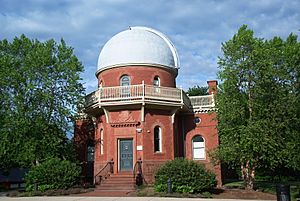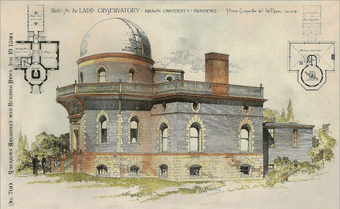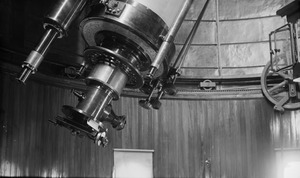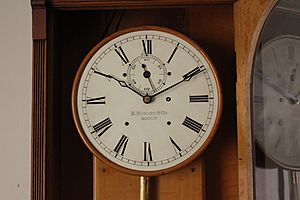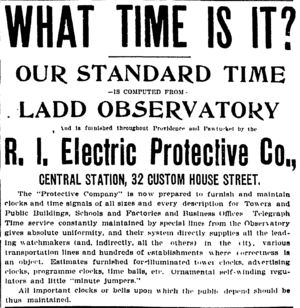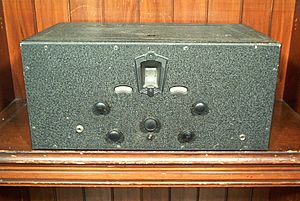Ladd Observatory facts for kids
The Ladd Observatory is a cool place where people study stars and planets! It's located at Brown University in Providence, Rhode Island. It opened way back in 1891. Its main job was to help students learn about space and for scientists to do research.
For many years, Ladd Observatory also helped keep time for the whole area. They made sure clocks on campus, like the one at Carrie Tower and the bell that rang for classes at University Hall, were super accurate. They even used special tools to record weather observations right from the start!
Besides regular astronomy classes, students learned about things like geodesy (measuring Earth's shape) for civil engineering. During World War I, students also learned celestial navigation. This is how sailors use the stars to find their way.
Ladd Observatory started having open nights for the public in 1930. This led to the creation of the Skyscrapers amateur astronomy club in 1932. This group often met at Ladd. Later, they got their own place, the Seagrave Memorial Observatory. But amateur astronomers from the Skyscrapers still helped out at Ladd. They even joined Brown University on trips to see solar eclipses. For one eclipse trip in 1937, they built a special Schmidt camera.
In 2000, Ladd Observatory was added to the National Register of Historic Places. It's still used by Brown University's Physics Department for teaching astronomy. Plus, it's often open to the public as a fun science center and technology museum.
Contents
Building the Observatory
The observatory is named after Herbert W. Ladd. He offered to pay for the building in 1889. The building was designed by a company called Stone, Carpenter & Willson. They built it in a style called Classical Revival.
The place chosen for the observatory was the highest spot in Providence at the time. It was known as Tintop Hill on the East Side. Building started in May 1890. The observatory officially opened on October 21, 1891. The total cost to build and equip it was about $40,000 in 1891.
Amazing Telescopes
The main telescope at Ladd is a refractor. This type of telescope uses lenses to gather light. Its main lens is 12 inches wide and 15 feet long. The lens was made by John Brashear based on a design by Charles S. Hastings. The special glass for the lens came from Paris and Germany.
The telescope's equatorial mount and mechanical clock drive were made by George N. Saegmuller. The mount helps the telescope follow stars as Earth rotates. The clock drive keeps it moving smoothly. This telescope was used for important science work. For example, it helped measure the Moon's orbit by timing when it passed in front of stars (called occultation). You could also attach tools like a filar micrometer to the telescope. This tool helps measure small distances in the sky.
Another telescope, a 3-inch meridian circle, was also made by Saegmuller. This telescope was used for observations related to keeping accurate time. Smaller, similar telescopes were used to teach students.
Keeping Perfect Time
In the late 1800s, many observatories, including Ladd, provided accurate time services. They sent out a time signal using telegraph wires. To do this, they watched specific stars cross the meridian (an imaginary line in the sky). This helped them set a very good pendulum clock to sidereal time (time based on the stars).
Then, they calculated how to change sidereal time into local standard time. A second clock, set to standard time, had a special device. This device automatically sent out the time signals through the telegraph. These super-accurate clocks were called astronomical regulators. Ladd used regulators made by famous clockmakers like Robert Molyneux and Edward Howard.
Before Ladd started its service, Providence got time signals from other observatories. But these signals were often wrong because of delays or problems with the telegraph lines. Ladd started sending its own time signals on September 12, 1893. The observatory sold these signals to a local company called Rhode Island Electric Protective (RIEP). This company used the signals for fire and burglar alarms. They also sent the signals to "jewelers" (who were often clockmakers) to help them fix and set watches.
The signals also controlled hundreds of slave clocks in different offices. These clocks would automatically set themselves using the signal. In 1906, Brown University earned about $200 a year from this time service. Another telegraph wire connected the observatory to the Fire Department at City Hall. This allowed them to signal the accurate time to the community. Fire alarm bells would ring at noon and 8:30 p.m. every day. Ladd's time signals also kept the clock in University Hall accurate. This clock rang the bell for class periods.
In November 1913, Ladd started getting experimental wireless time signals. These came from the Naval Observatory in Washington. The goal was to measure the distance between Washington and Providence more accurately. The signals were sent by a Navy radio station in Arlington, Virginia.
In 1915, Brown University put in a fancy "wireless plant." It had a 450-foot-long antenna strung between two towers on campus buildings. The radio equipment was in the basement of Wilson Hall. It was mainly for teaching engineering and physics. But it also received the time signals from Arlington. On November 24, 1916, Ladd stopped using star observations to set its clocks. Instead, they used the radio signals. However, they had to go back to star observations on April 10, 1917. This was because the U.S. government ordered them to take down their radio when the U.S. entered World War I. They continued star observations until October 16, 1919.
After the war, Ladd started receiving time signals again. These came from the Naval Observatory's radio station WWV. These early signals were longwave, meaning they had very long wavelengths. They needed special equipment to receive them. But by the 1930s, it became easy to use a simple, cheap shortwave radio. These radios were like the ones people used to listen to music. This radio could also get time signals from places like Greenwich, Paris, and Berlin. The radio was connected directly to the observatory's clocks. This allowed them to record the time signals.
Fire station sirens in Providence continued to sound at noon using Ladd's time signals until at least 1955. Many clocks in Providence buildings were set by Ladd's signals even into the 1970s. But in 1973, after realizing no one was using the signals anymore, Ladd stopped sending them out.
People Connected to Ladd
Many scientists worked at Ladd Observatory. These include Winslow Upton, Frank Washington Very, Frederick Slocum, Robert Horace Baker, and Charles H. Smiley. Some notable students from Brown or Pembroke College who worked at Ladd include Frederick Slocum, Leah Allen, and Harlan True Stetson.
Even the famous author H. P. Lovecraft, who wrote spooky stories, had free access to the observatory for several years. He wrote astronomy articles for Providence newspapers based on what he learned there between 1906 and 1918.
Images for kids


